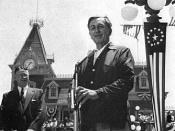There were many different entrepreneurs in the animation industry. From ancient times, animation has been a goal of artists. Since then, many different inventions and developments have been made to further improve the portrayal of animation. It is arguably said that there is one person who stands above the rest of them in the art of animation. That man is Walt Disney.
Since the beginning of time, artists have been trying to depict motion in their art. The earliest recorded illustration that portrayed motion can be found on an Egyptian wall decoration circa 2000 B.C.C. (Chew 24) It is similar to today's comic strips, in that its successive panels depict the actions of two wrestlers in a variety of holds. Prehistorically, the attempt to depict action in art was very evident. In cave drawings around the globe there are drawings of animals with eight legs, representing the animal running (Chew 29).
Without first understanding a fundamental principle of the human eye, true animation cannot be achieved. This principle is the persistence of vision. This idea was first demonstrated in 1828 by Paul Roget, who invented the thaumatrope. This device was a disk attached to a stick or pole, with an image of a bird on one side and an image of a cage on the other. The bird appeared to be in the cage when the disc was twirled. This apparatus proved that the eye retains images when it is exposed to a series of pictures, one at a time (Chew 40).
Two other inventions that helped to further the cause of animation were the phenakistoscope and the zerotrope. The phenakistoscope was created by Joseph Plateau in 1826. It was a circular card with slits around the edge. The viewer held the card up to a mirror and peered through...


